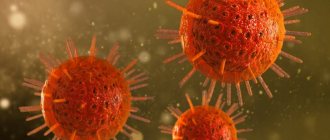Hello dear readers of my blog!
In the last article, I told you about viral skin diseases of children and adults in general terms. Today I will tell you about herpes simplex.
If we start a little with science, there are currently 3 subfamilies formed in the Herpesviridae family. So, one of the families - Alphaherpesvirrianae - includes 3 types of herpes virus:
— human herpes virus 1 – herpes simplex virus type 1 (HPV-1);
- human herpes virus 2 - herpes simplex virus type 2 (HPV-2);
- human herpes virus 3 - varicella zoster virus (VZV).
Conventionally, the first type of herpes can be called labial, and the second genital.
Since herpes simplex is one of the most common viral diseases in humans, I want to dwell on it. Every year, 500,000 people worldwide become ill with it, and according to the World Health Organization, about 3.7 billion people are infected with herpes simplex virus type 1 (HPV-1) worldwide.
It is believed that more than 90% of the world's population is infected with HSV and 10-30% experience clinical manifestations.
A distinctive feature of herpes viral infections is that once it enters the human body, it remains there for life.
The question immediately arises: how can one become infected with one or another herpes? The answer is anyone. Thus, in 40% of cases, HSV infection occurs through airborne droplets in early childhood, often from family members.
Naturally, it is also possible to transmit genital herpes through sexual contact, but this is also not a 100% sure way.
How can you get infected with herpes
The content of the article
The disease is caused by the herpes simplex virus (HSV, Herpes simplex virus). Of the eight types of this pathogen, genital lesions are the result of two infectious agents. HSV-2 causes 80% of cases of the disease, and HSV-1 - 20%. There are also combined infections, in which both viral types are to blame.
There is a misconception that herpes on the lips and genitals are completely different diseases. In fact, both types of pathogens often “swap places” during domestic infection and oral sex. And both infections are equally dangerous.
Both types of virus are transmitted:
- For all types of sexual contact - vaginal, oral, anal, during which the virus enters the body through microdamage to the mucous membrane. You can also become infected from a partner who does not have rashes on the genitals or other manifestations of the disease. This condition is possible with strong immunity, when the virus lies low and waits in the wings. A person becomes a carrier of a herpes infection, but does not experience any health problems.
- Through common objects - washcloths, sponges, bed linen, towels. A person with a cold sore caused by the type 1 virus can become a source of genital herpes infection.
- During autoinoculation (self-infection), when the patient transfers the pathogen from the face to the genitals.
- A child becomes infected from a sick mother when the virus penetrates from the vagina into the uterus or transplacentally through the placenta. During childbirth, infection occurs as the newborn passes through the birth canal.
Statistics of hidden and overt forms of herpes
The body cannot overcome the pathogen on its own. The virus settles in the roots of the spinal cord, and the infected person continues to live with the disease throughout his life.
The pathogen can remain in the body for many years without causing symptoms. Therefore, it is impossible to know without testing for herpes whether a person is infected with the virus. According to WHO, type 1 herpes, which causes a rash on the lips and genitals, affects 67% of the world's inhabitants, and type 2 affects 11% of people. Only 20% of the disease occurs in the classical form, which is beyond doubt. In the rest, the course of the disease is latent or asymptomatic.
What it is?
Herpes zoster is a sporadic disease caused by reactivation of the herpes virus type III (Varicella Zoster virus). The disease is characterized by primary damage to the skin and nervous system with severe complications.
When varicella-zoster viruses enter the human body, they quickly spread through the blood, cerebrospinal fluid and nerve sheaths. Settling in the nerve cells of the spinal ganglia, they persist there for life. Hypothermia, insolation, alcohol abuse, physical and mental trauma, hormonal cycles - everything that attacks the immune system provokes an exacerbation of the disease. Having a tropism for cells of the nervous system, varicella-zoster viruses cause diseases that often occur as an infectious disease of the central and peripheral nervous systems.
Lifelong latent carriage of varicella zoster has been established in approximately 20% of residents of our country who had chickenpox in childhood. Asymptomatic carriage of a “dormant” virus can be lifelong. The main refuge for it is the nerve cells of the body. Under the influence of internal and/or external agents, the virus is activated.
Primary herpes
There are three periods of illness:
- Prodromal
(precursor period), during which the temperature rises, the inguinal lymph nodes become inflamed, weakness, fatigue, and headache appear. A person experiences a condition similar to the symptoms of flu and colds. If you take an antiviral drug during this period, the disease may not develop. If the symptoms are ignored and treatment is not started on time, the second period of the disease begins. - A rash
that occurs three to four days after the onset of a flu-like condition. Common symptoms include pain, heat, swelling, itching in the genital area, anus, buttocks, pubis and perineum. Soon, numerous blisters filled with clear liquid appear on the inflamed skin and mucous membranes, reminiscent of a “cold” on the lips. The rash causes pain and itching, worse at night and leading to insomnia. - Ulcerations.
After some time, the blisters burst and ulcers (erosions) form in their place, surrounded by a focus of inflammation. Contact with stool and urine on the eroded surface increases pain and complicates tissue regeneration. - Healing,
during which the ulcers gradually heal. If the genital organs are poorly cleaned, the immune system is weak, and infection occurs, the healing process is delayed.
After the ulcers disappear, the disease goes into remission. During this period, despite the presence of the virus in the body, there are no rashes on the genitals.
Initial period
Prodromal, characterized by general malaise, neuralgic pain of varying intensity, this lasts on average 2-4 days:
- Headache
- Low-grade body temperature, less often fever up to 39C
- Chills, weakness
- Dyspeptic disorders, gastrointestinal dysfunction
- Pain, itching, burning, tingling in the area of the peripheral nerves in the area where the rash will later appear.
- Most often, during an acute process, regional lymph nodes become painful and enlarged.
- In severe cases of the disease, urinary retention and other disorders of certain systems and organs may occur.
After the temperature decreases, other general intoxication disorders also weaken.
Recurrent herpes
In 50%-70% of people the disease becomes chronic. This is facilitated by:
- untimely or incorrect treatment;
- decreased immunity, including that caused by taking medications that suppress the immune system;
- presence of other STDs;
- strict diets, vitamin deficiencies;
- state of chronic stress.
Why do patients develop relapses, during which the disease affects the same parts of the body? There are several reasons for this:
- Having penetrated the body, the virus settles in the tissues of the genital organs. As it multiplies, it affects cells deeper and deeper until it reaches nerve cells - neurons connected to each other by processes - axons. Through them, like bridges, the pathogen reaches the cells of the spinal cord, into which it introduces its DNA.
- An infected brain cell becomes an “incubator” for viruses, which periodically return via axon bridges to the mucous membrane or skin, causing new rashes. Schematically, the process is similar to the migration of birds, constantly returning to their “native places.”
- The immune system cannot kill viruses hidden in the spinal cord, but it deals with those that have left the “shelter”. Therefore, with high immunity, relapses occur rarely or not at all. But as soon as the body “loses its vigilance” - weakens, gets sick, catches a cold, is exposed to stress - the pathogens begin to overcome the immune defense. As a result, they reach their target - the skin and mucous membranes of the genital organs. Here, the increased reproduction of viral particles inside the “captured” cells begins. Cellular structures, dying, release myriads of viruses that cause inflammation, redness, swelling and the appearance of blisters. Herpes is causing another aggravation.
- Gradually, the immune system fights back the virus, and within 10 days the ulcers at the site of the rash dry out and heal. Everything returns to normal, so that at the slightest weakening of the immune system it can start again.
From the mechanism of exacerbations, it becomes clear why herpetic eruptions appear in the same places. It’s just that the virus cells return back only through the nerve cell from which they penetrated deep into the body.
Types of recurrent herpes
Depending on the number of exacerbations, several types of the disease are distinguished:
- mild, occurring up to 3 times a year;
- moderate severity, in which exacerbations occur 4-6 times a year;
- severe, accompanied by frequent exacerbations, intervals between which do not exceed a month;
- arrhythmic, in which after a period of imaginary well-being, lasting from a month to five, rashes appear. This form of herpes is characterized by a pattern - the longer the remission, the more severe the disease;
- menstrual, manifested by rashes during menstrual periods. This type of disease is severe and difficult to treat;
- subsiding, in which the manifestations of the disease constantly become weaker, and the inter-relapse periods become longer. The subsidence of the manifestations of the disease indicates the positive dynamics of treatment and the restoration of immune defense that suppresses the virus.
Period of rash
The time when rashes characteristic of shingles appear. The symptoms and nature of the rash depend on the severity of the inflammatory process. At first, the rashes look like pockets of pink spots 2-5 mm in size, between which there are areas of healthy skin.
- In the typical form of the disease, the next day, small, closely grouped vesicles and vesicles with transparent serous contents form in their place, which becomes cloudy after 3-4 days.
- In severe gangrenous form of herpes, the contents of the vesicles may be mixed with blood and black in color. Herpetic rashes have a wave-like course, as with chickenpox, that is, fresh rashes with vesicular elements appear at intervals of several days. The bubbles seem to crawl from one place to another, encircling the body, hence the name of this disease.
In mild forms of the inflammatory process, the transformation of skin nodules into pustules does not form and their ulceration does not occur, and the manifestation of herpes is also possible only of a neurological nature - pain without a rash, otherwise it is also called herpetic neuralgia and is often mistaken for manifestations of intercostal neuralgia, osteochondrosis or heart pain. And therefore, inadequate treatment may be prescribed.
Atypical forms of herpes
Sometimes genital herpes is erased. These forms of the disease account for 65% of cases of the disease:
- In women,
atypical herpes resembles inflammation of the vagina or vulva. There is pain, itching and swelling of the genital organs, profuse leucorrhoea and pain during sexual intercourse. External manifestations are limited to areas of redness or pinpoint rashes. - In men,
the atypical form of the disease is similar to inflammation of the head and foreskin (balanitis or balanoposthitis). A reddish rash appears on the mucous membrane of the penis, accompanied by pain and burning, which does not look like a herpetic rash. Inflammation of the prostate gland occurs, causing pain radiating to the anal area. Damage to the urethra leads to pain and burning when urinating, and the appearance of traces of blood in the urine.
There is a latent form of the disease in which there are no clinical manifestations, but despite this, the person remains a source of infection. But imaginary well-being does not last forever. With hypothermia, loss of strength, decreased immune defense, pregnancy, stress, severe concomitant diseases and other unpleasant conditions, the virus begins to multiply rapidly and the person becomes ill.
The disease is activated by concomitant sexually transmitted infections, especially ureaplasmosis. Due to the ability to rapidly “bloom” against a background of weakened immunity, herpes occurs in 90% of HIV patients. Therefore, if herpetic rashes appear, you need to be examined for other STDs.
Story
Shingles was known in ancient times, but was considered as an independent disease. At the same time, chickenpox was often mistaken for smallpox for a long time: despite the fact that the clinical differences between these two infections were described back in the 60s of the 18th century, reliable differentiation became possible only at the end of the 19th century.
The infectious nature of chickenpox was proven by Steiner in 1875 in experiments on volunteers. Assumptions about the connection between chickenpox and herpes zoster were first made in 1888 by von Bokay, who observed chickenpox in children after contact with patients with herpes zoster. These ideas were confirmed only in the late 1950s, when T. Weller isolated the pathogen from patients with both clinical forms of infection.
However, epidemiological data turned out to be the most convincing: the incidence of chickenpox in areas of herpes zoster was significantly higher than the average among the population (in areas of herpes zoster the secondary risk of infection is high). In 1974, Takahashi and his colleagues obtained a weakened Oka strain of the “wild” virus, and in 1980 a clinical trial of a vaccine against chickenpox was started in the United States.
Features of the course of genital herpes during pregnancy
The number of positive (seropositive) reactions to herpes viruses 1 and 2 in pregnant women is 50-70%. Due to the increased load on the body and decreased immune defense, herpes often relapses during this period. But only 30% of women experience the classic development of the disease. Basically, the symptoms of herpes during pregnancy are limited to the appearance of areas of redness and cracks, which women mistake for irritation.
The manifestation of a herpetic infection caused by recurrence is not dangerous for the child. The woman’s body has already built up immunity to infection by producing antibodies—substances that protect her from the virus. Some of the antibodies will pass from mother to baby, protecting him from infection.
Only a relapse that occurs immediately before childbirth is dangerous. To prevent infection of the baby and rupture of inflamed tissues, women with a herpetic rash on the genitals are advised to deliver by cesarean section.
It is much worse when the infection is primary. Herpes belongs to a group of infections, infection of which for the first time during pregnancy leads to the birth of children suffering from developmental delays and congenital defects.
Herpes tests for pregnant women: interpretation and prognosis of pathologies in the fetus
To determine the degree of risk for the baby, a woman’s blood is taken for IgM and IgG antibodies, the concentration of which determines when infection occurred. The analysis is carried out using the ELISA method (immunofluorescence), which reacts to IgM and IgG antibodies to the virus. By the presence or absence of antibodies, you can find out whether a woman is infected and when the infection occurred:
- IgM antibodies
appear after 2-3 weeks. after the onset of the disease, therefore indicating a “fresh” infection or relapse of infection. These antibodies disappear after 1-2 months. after recovery. The presence of IgM in the analysis is a bad sign. - IgG class antibodies
- appear as protection against the virus after 2 weeks. field of infection, quickly increase the titer (concentration) and persist throughout life. Their detection means that the body encountered a herpes infection and managed to cope with it.
It is bad if a fourfold increase in IgG is combined with the detection of IgM. This means that antibodies are being formed right now, i.e. the woman is sick.
Infection with the herpes virus is determined in the laboratory. It is better to undergo such an examination twice - before pregnancy and during it.
Table of interpretation of results for herpes
| IgM | IgG | What does it mean | What to do | |
| — | — | The woman is healthy (seronegative) - she has never had herpes | Before pregnancy | During pregnancy |
| In order not to become infected, you need to avoid contact with people who have manifestations of herpes, incl. on the lips. Periodic antibody monitoring is recommended | ||||
| — | + | Female carrier (seropositive) | The infection occurred a long time ago and does not pose a danger to the child, no measures are needed | |
| + | — | Recent infection | It is better to plan pregnancy after acute symptoms subside and re-examination | Consult a doctor and undergo additional diagnostics to find out if everything is okay with the baby. |
| + | + | Exacerbation of infection | It is better to plan pregnancy after acute symptoms subside | Recurrent herpes is less dangerous than primary herpes, so the likelihood of complications and intrauterine infection is only 0.02% |
Fetal pathologies in children infected with herpes during pregnancy
The most dangerous thing for a child is primary infection of the mother during pregnancy, which leads to many complications.
| Gestational age at primary infection | Possible complications |
| I trimester (up to 13 weeks) | Fading pregnancy, miscarriages, severe malformations |
| II trimester (14-27 weeks) | Child infection, internal organ defects, fetal death |
| III trimester (29-40 weeks) | Intrauterine infection, death of a child after birth, premature birth, hearing, vision, and nervous system defects of the child. Subsequently - mental retardation. |
Folk remedies
All of the following recipes for plant herbs (optional) are prepared as follows: leave one tablespoon of herbs in a glass of boiling water for 20-30 minutes, cool and consume 1/2-1/3 cup 2-3 times a day to relieve mild pain and nervous excitability , as well as for insomnia.
- Valerian root, mint leaves - 3 parts each, watch leaves - 4 parts.
- Mint leaf, watch leaf - 2 parts each, valerian root and hop cones - 1 part each.
- Fennel fruits and chamomile flowers - 1 part each, marshmallow root, licorice root, wheatgrass rhizome - 2 parts each (recommended for children).
- Valerian root – 2 parts, chamomile root – 3 parts, caraway fruit – 5 parts.
- Valerian root, hawthorn flowers, mint leaves, mistletoe herb, motherwort herb - 1 part each.
- Valerian root, motherwort herb, green oat straws - 1 part each.
- Tatar leaves, green oat straw, caraway fruits - 2 parts each, hawthorn flowers, chamomile flowers - 1 part each.
- Mint leaves - 1 part, heather grass, lemon balm leaves - 2 parts each, valerian root - 4 parts.
- Heather leaves, cudweed herb, thyme herb, valerian root - 2 parts each, chicory root - 1 part.
- Motherwort grass, cudweed grass, heather grass - 2 parts each, hop cones, caraway fruits - 1 part each.
The use of medicinal pharmacopoeial herbs is justified in mild forms of the pathogenesis of herpes zoster.
Herpes in newborns
A child becomes infected with the pathogen from the mother in utero or by passing through an infected genital tract during childbirth. In newborns, the mucous membranes of the eyes and mouth, skin, and genitals are affected. When the pathogen enters the child’s brain, meningoencephalitis occurs, causing death or severe disability.
A generalized form is possible, in which all organs and systems of the newborn are affected. The child experiences jaundice, respiratory distress, and urinary retention. Children are restless, do not latch on to the breast, and are vomiting. Death occurs from shock, bleeding, dehydration, intoxication, and organ failure.
The likelihood of infection increases with primary infection of the mother in late pregnancy.
Diagnosis of herpes
If genital herpes is suspected, after an external examination, scrapings from the affected areas, blood, and urine are taken for examination. This will allow you to differentiate the disease from other skin lesions that have similar symptoms.
For diagnostics the following is used:
- Cultural method - during the study, the contents of the vesicles are transferred to a growing chicken embryo; if it dies, the disease is confirmed. The method is reliable, but too time-consuming.
- PCR is a test that detects viral DNA in tissues. The method allows you to calculate the pathogen even from a small amount of viral material. Effective for diagnosing any form of disease, incl. hidden. The method can be used immediately after infection before symptoms of the disease appear. PCR not only detects the virus, but also determines its type.
- Methods aimed at determining antigens and antibodies to the pathogen: ELISA - immunofluorescence diagnostics, CFR (complement fixation reaction), various types of agglutination reactions. With their help, you can identify the type of pathogen, determine its quantity and duration of infection.
A complete diagnosis of herpes virus infection allows you to make the correct diagnosis in order to prescribe treatment.
Vaccination
A live vaccine known as Zostavax has been proposed against the occurrence of the disease.
This vaccine rarely causes side effects but is contraindicated in immunocompromised patients and may not be effective in patients taking antiviral drugs active against Varicella zoster virus. From an economic point of view, it is advisable to use it for patients over 60 years of age.
A Cochrane Library systematic review of eight randomized, placebo-controlled trials involving 52,269 participants found that the Zostavax vaccine in older adults prevented one episode of herpes zoster in every 70 people vaccinated, meaning it was effective in reducing the risk of herpes zoster by almost 50%. Side effects caused by the vaccine were mainly mild to moderate symptoms at the injection site[16].
Complications of herpes
The worst thing is that a herpes infection brings not only unpleasant symptoms. This virus causes many terrible complications. The most obvious ones are:
- Irritation and dryness of the skin and mucous membranes of the genital organs;
- Cracks in the genitals caused by metabolic disorders in tissues caused by herpes;
- Adhesive and cicatricial deformities of the labia, vaginal opening, perineum, urethra and rectum. The complication arises due to the specific feature of herpetic rashes appearing on the same areas of the skin and mucous membranes
- Cervical erosion leading to cancer of the reproductive organs.
- Lacerations during childbirth caused by poor distensibility of inflamed perineal tissue.
- Infection of ulcers due to microbes entering tissues not protected by the mucous membrane;
- cicatricial deformities of the penis, provoked by constant inflammatory rashes and ulcerations.
- Chronic herpetic lesions of the genitourinary area, spreading to the urethra, bladder and kidneys.
- Herpetic proctitis is inflammation of the rectum.
- Erectile dysfunction and male and female infertility.
- Neurological symptoms caused by a viral infection of the nervous system. Patients complain of pain in the sacrum, lower back, and groin. With recurrent lesions on the inner surface of the thighs, hypersensitivity of the skin occurs, manifested by a burning sensation, crawling “goosebumps”, tingling.
In severe cases, with a pronounced weakening of the immune system, viremia occurs - viral infection of the blood leading to damage to the brain, liver, lungs, adrenal glands, and intestines. This condition, even with adequate treatment, is often fatal.
Treatment of genital herpes
It is difficult to cure such a dangerous disease. Treatment of genital and labial herpes is long and complex. Therapy includes:
- Prescription of antiviral agents that slow down the reproduction (replication) of viruses. To maintain the effectiveness of treatment during long-term therapy, it is necessary to constantly change the prescribed medications.
- The use of drugs based on interferons - proteins released in response to viral invasion. Scientists have found that a lack of this substance provokes exacerbations of the disease.
- The use of local antiviral ointments, gels and sprays that kill viruses that have penetrated the skin and mucous membranes.
- Prescribing symptomatic medications that combat the general symptoms of the disease - reducing pain, swelling, inflammation, lowering temperature, normalizing sleep.
- Local procedures - baths and irrigations that relieve pain and prevent the penetration of secondary infections.
- Taking immunoglobulins, immunomodulators and stimulators of cellular immunity, which improve the functioning of the immune system, activate the production of antiviral antibodies and prevent relapses.
Patients suffering from genital herpes are advised to avoid wearing synthetic underwear.
Prevention of infection consists of a thoughtful choice of sexual partners, compliance with hygiene rules, periodic examination by a gynecologist and the use of emergency measures at the first symptoms of the disease.
Where to get tested and cure herpes in St. Petersburg, prices
Doctors at the modern Diana Clinic treat herpes infections in St. Petersburg. Here you can take express tests for all infections - smears, blood, etc. Tests are performed using the best methods - PCR, ELISA, etc. The cost of visiting a doctor based on test results is 500 rubles. The price of tests depends on the type of examination. For example, the cost of taking blood from a vein is only 170 rubles.










